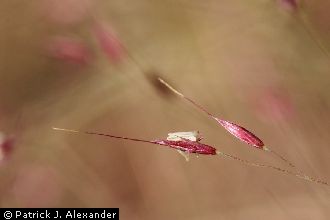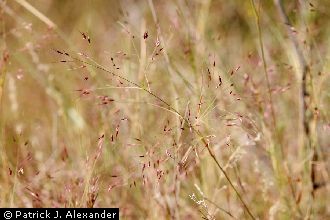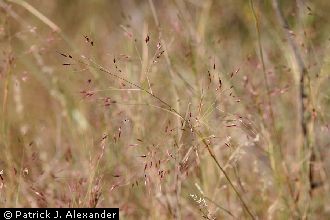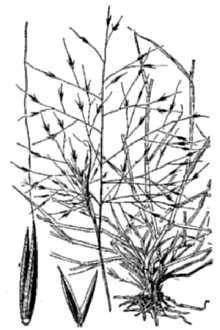Bush Muhly
Scientific Name: Muhlenbergia porteri Scribn. ex Beal

| General Information | |
|---|---|
| Usda Symbol | MUPO2 |
| Group | Monocot |
| Life Cycle | Perennial |
| Growth Habits | Graminoid |
| Native Locations | MUPO2 |
Plant Guide
Description
General: Bush muhly is a native perennial, warm-season, shrubby bunchgrass that grows 1.5 to 3 ft tall and wide. The common name refers to the bush-like appearance of plants; the plants are also often seen spreading up through the branches of bushes. Bush muhly has a semi-woody, decumbent base that is not rhizomatous. Culms are wiry, bent at the nodes, branching and intertwined. Leaf blades are very narrow, up to 3 inches long, and may be flat or folded. The inflorescence is an open panicle 2 to 4 inches long with thread-like branches. The spikelets may have a purple color in cool weather. Bush muhly begins growth in late winter or early spring, and flowers from early spring through summer (Kearney and Peebles, 1964; Hitchcock, 1971; Felger et al., 2014; Peterson, 2012; USU, 2017). Distribution: Bush muhly occurs in arid regions of California, Nevada, Utah, Colorado, Arizona, New Mexico, Oklahoma, Texas, and in Northern Mexico. For current distribution, please consult the Plant Profile page for this species on the PLANTS Web site. Habitat: Bush muhly grows on mesas, rocky slopes, and along drainages. It typically occurs at elevations between 2000 and 6000 feet above sea level. Bush muhly is most commonly found in areas that are protected from grazing (within shrubs, between boulders). It was formerly a dominant grass in southern Arizona but is now generally found in limited quantities throughout its range due to overgrazing (Ruyle and Young, 2003).
Adaptation
Bush muhly is a C4 grass adapted to hot, arid conditions. It is considered a climax species (Glendening et al., 1955). Bush muhly is tolerant of a wide variety of soil textures. It tolerates calcium carbonate but not soil salinity. During dry and cool periods bush muhly may behave like a shrub, with its leaves dying back to the nodes (Van Devender and Dimmitt, 2000). Under favorable conditions, leaves and inflorescences can quickly regrow from the nodes. Fire and hard frost cause the plants to die back to the crown, regrowing when conditions improve (Van Devender and Dimmitt, 2000). Bush muhly has a higher water use efficiency than creosote bush (Castellanos-Pérez et al, 2008) or mesquite seedlings (Glendening et al., 1955), giving it the ability to inhibit the growth of these competitors. Bush muhly can survive under mesquite canopies (Jacoby et al., 1982). Associated plants include velvet mesquite (Prosopis velutina), ironwood (Olneya tesota), catclaw acacia (Senegalia greggii), creosote bush (Larrea tridentata), saguaro (Carnegiea gigantea), Joshua tree (Yucca brevifolia), banana yucca (Yucca baccata), desert spoon (Dasylirion wheeleri), fourwing saltbush (Atriplex canescens), sagebrush (Artemisia tridentata), brittlebush (Encelia sp.), broom snakeweed (Gutierrezia sarothrae), tobosagrass (Pleuraphis mutica), purple threeawn (Aristida purpurea), sand dropseed (Sporobolus cryptandrus), and cane bluestem (Bothriochloa barbinodis).
Uses
Grazing: Bush muhly is highly palatable remaining green through most of the year when moisture is available. However, its branching habit makes it susceptible to damage by overgrazing (Utah State University, 2017). Formerly abundant, it is now more commonly found in places where livestock cannot reach it. Bush muhly was grazed out of large areas of Organ Pipe, AZ, prior to the creation of the National Monument. After cattle were removed, it increased to become common within the Bush muhly. (Photo by Heather Dial, USDA-NRCS Tucson Plant Materials Center) Plant Guide Monument (Felger et al., 2014). Wildlife: Desert tortoises eat bush muhly and may also use the plants for shelter (Felger et al., 2014; McArthur et al. 1994). Cactus wrens commonly gather bush muhly for nesting material, probably dispersing the seeds in the process (Milton et al 1999).
Ethnobotany
The Tohono O’odham word for bush muhly, ku:kpadag, means “plant formerly used to close water containers” (Hill and Zepeda, 1994), suggesting that clumps of bush muhly were used as stoppers.
Status
Threatened or Endangered: No. Wetland Indicator: Bush muhly is an upland (UPL) plant. Weedy or Invasive: Bush muhly is not known to be weedy or invasive. Please consult the PLANTS Web site (http://plants.usda.gov/) and your state’s Department of Natural Resources for this plant’s current status (e.g., threatened or endangered species, state noxious status, and wetland indicator values).
Planting Guidelines
Bush muhly typically reproduces by seed. The recommended seeding rate for bush muhly is 0.45 pure live seed (PLS) pounds per acre if planted with a drill and approximately 0.9 PLS pounds per acre if seed is broadcast. There are approximately 2,424,000 seeds of bush muhly in a pound (USDA-PLANTS Database). For containerized production, no pre-treatment methods are necessary as seeds are non-dormant (Baskin and Baskin, 2002).
Management
Protect bush muhly from overgrazing. When possible, defer grazing in late summer every second or third year allowing the plants to set seed (Ruyle and Young, 2003; Allison and Ashcroft, 2011).
Pests and Potential Problems
None known, Use soil moisture sensors to measure the soil moisture of Bush Muhly.,
Environmental Concerns
Concerns
Concerns
None known.
Seed and Plant Production
Plant Production
Plant Production
Bush muhly seed should be planted in the early spring into a firm, weed free seedbed at a depth of 1/4 inch. New seedings should be irrigated to maintain a moist soil surface and to avoid soil crusting. Plugs should be planted with 40-48 inches between rows, and 36-40 inch within-row spacing. Control weeds as needed with an appropriate herbicide after plants have developed at least 3-5 leaves. Apply nutrients according to soil test results. Irrigate established fields approximately every four weeks during the growing season. Irrigated fields produce seed in summer. Harvest with a seed stripper or combine. Clean harvested seed by processing with a hammermill or brush machine to break up the panicles; follow with air screening. Cultivars, Improved, and Selected Materials Limited amounts of this species are available on the commercial market. Currently, none are listed as cultivars, improved or selected materials.
Literature Cited
Allison, C.D. and N. Ashcroft. 2011. New Mexico Range Plants. Circular 374. [Online]. Available at https://aces.nmsu.edu/pubs/_circulars/CR374/ (accessed on 30 May 2019). College of Agricultural, Consumer and Environmental Sciences, New Mexico State University, Las Cruces, New Mexico. Baskin, J.M. and C.C. Baskin. 2002. Propagation protocol for production of container (plug) Muhlenbergia porteri Scribn. plants [Online]. Available at http://NativePlantNetwork.org (accessed on 13 March 2019). In: Native Plant Network. USDA, Forest Service, National Center for Reforestation, Nurseries, and Genetic Resources. University of Kentucky, Lexington, Kentucky. Bush muhly production fields at the USDA-NRCS Tucson Plant Materials Center. (Photo by Heather Dial)
Plant Traits
Growth Requirements
| Temperature, Minimum (°F) | 12 |
|---|---|
| Adapted to Coarse Textured Soils | Yes |
| Adapted to Fine Textured Soils | Yes |
| Adapted to Medium Textured Soils | Yes |
| Anaerobic Tolerance | None |
| CaCO3 Tolerance | None |
| Cold Stratification Required | No |
| Drought Tolerance | High |
| Fertility Requirement | Medium |
| Fire Tolerance | High |
| Frost Free Days, Minimum | 220 |
| Hedge Tolerance | None |
| Moisture Use | Medium |
| pH, Maximum | 8.0 |
| pH, Minimum | 6.2 |
| Precipitation, Maximum | 12 |
| Precipitation, Minimum | 5 |
| Root Depth, Minimum (inches) | 12 |
| Salinity Tolerance | Low |
| Shade Tolerance | Intermediate |
Morphology/Physiology
| After Harvest Regrowth Rate | Slow |
|---|---|
| Toxicity | None |
| Shape and Orientation | Decumbent |
| Nitrogen Fixation | None |
| Resprout Ability | No |
| Active Growth Period | Spring, Summer, Fall |
| Bloat | None |
| C:N Ratio | Medium |
| Coppice Potential | No |
| Fall Conspicuous | No |
| Fire Resistant | No |
| Flower Color | Yellow |
| Flower Conspicuous | No |
| Foliage Color | Green |
| Foliage Porosity Summer | Dense |
| Foliage Texture | Fine |
| Low Growing Grass | No |
| Lifespan | Long |
| Leaf Retention | Yes |
| Known Allelopath | No |
| Height, Mature (feet) | 2.8 |
| Growth Rate | Moderate |
| Growth Form | Single Crown |
| Fruit/Seed Conspicuous | No |
| Fruit/Seed Color | Brown |
| Foliage Porosity Winter | Moderate |
Reproduction
| Vegetative Spread Rate | Slow |
|---|---|
| Small Grain | No |
| Seedling Vigor | Medium |
| Seed Spread Rate | Slow |
| Seed per Pound | 2424000 |
| Fruit/Seed Persistence | No |
| Propagated by Tubers | No |
| Propagated by Sprigs | No |
| Propagated by Sod | No |
| Propagated by Seed | Yes |
| Propagated by Corm | No |
| Propagated by Container | No |
| Propagated by Bulb | No |
| Propagated by Bare Root | No |
| Fruit/Seed Period End | Summer |
| Fruit/Seed Period Begin | Summer |
| Fruit/Seed Abundance | Low |
| Commercial Availability | Contracting Only |
| Bloom Period | Late Spring |
| Propagated by Cuttings | No |
Suitability/Use
| Veneer Product | No |
|---|---|
| Pulpwood Product | No |
| Protein Potential | Medium |
| Post Product | No |
| Palatable Human | No |
| Palatable Graze Animal | High |
| Palatable Browse Animal | High |
| Nursery Stock Product | No |
| Naval Store Product | No |
| Lumber Product | No |
| Fodder Product | Yes |
| Christmas Tree Product | No |
| Berry/Nut/Seed Product | No |



